An Ozone Episode in the Urban Agglomerations along the Yangtze River in Jiangsu Province: Pollution Characteristics and Source Apportionment
Abstract
:1. Introduction
2. Materials and Methods
2.1. Data Source
2.2. WRF-CMAQ Model
2.3. Emission Inventory
2.4. HYSPLIT Model
2.5. Evaluation of the Model Results
3. Results and Discussion
3.1. Model Simulation Evaluation
3.2. Analysis of the Variation Characteristics of Pollutants and the Weather Situation during the Contamination Process
3.3. Transmission Path Analysis
3.4. Ozone Sources
3.5. BVOCs Contributions
4. Conclusions
Author Contributions
Funding
Data Availability Statement
Acknowledgments
Conflicts of Interest
References
- Guo, Y.H. Spatiotemporal Pattern and Health Impact Assessment of Ozone Pollution in China; North-West University: Potchefstroom, South Africa, 2022. [Google Scholar]
- Zhao, Y.; Li, Y.; Kumar, A.; Ying, Q.; Vandenberghe, F.; Kleeman, M.J. Separately resolving NOx and VOC contributions to ozone formation. Atmos. Environ. 2022, 285, 119224. [Google Scholar] [CrossRef]
- Wan, W.X.; Zhang, S.H.; Li, J.; Sun, X.; Guan, Z.G.; Yu, X.H.; Yang, Y.H.; Wang, X.K. Regional differences in urban air ozone pollution and its damage to plants in Hebei Province. J. Ecol. Environ. Sci. 2021, 30, 2185–2194. [Google Scholar]
- Peng, L.; Li, Q.; Cai, Q.W.; Qiu, X.H. Impact of ozone on the yield and economic benefits of major food crops in China from 2015 to 2020. J. Saf. Environ. 2023, 23, 2958–2968. [Google Scholar]
- Wang, Y.; Song, Q.; Frei, M.; Shao, Z.; Yang, L. Effects of elevated ozone, carbon dioxide, and the combination of both on the grain quality of Chinese hybrid rice. Environ. Pol. 2014, 189, 9–17. [Google Scholar] [CrossRef] [PubMed]
- Monks, P.S.; Archibald, A.T.; Colette, A.; Cooper, O.; Coyle, M.; Derwent, R.; Fowler, D.; Granier, C.; Law, K.S.; Mills, G.E.; et al. Tropospheric ozone and its precursors from the urban to the global scale from air quality to short-lived climate forcer. Atmos. Chem. Phys. 2015, 15, 8889–8973. [Google Scholar] [CrossRef]
- Wu, Y.; Gu, J.; Shi, X.; Shen, W.; Zhang, H.; Zhang, X. Characteristics and formation mechanism of ozone pollution in demonstration zone of the Yangtze River Delta, China. Atmosphere 2024, 15, 382. [Google Scholar] [CrossRef]
- Shen, Y.; Liu, J.; Chen, Z.; Yang, M.; Shu, L.; Gai, C.; Jiang, Y. Influence of wind flows on surface O3 variation over a coastal province in Southeast China. Atmosphere 2024, 15, 262. [Google Scholar] [CrossRef]
- Zheng, S.C.; Jiang, F.; Feng, S.Z.; Liu, H.; Wang, X.Y.; Tian, X.D.; Ying, C.Y.; Jia, M.W.; Shen, Y.; Lyu, X.P.; et al. Impact of Marine Shipping Emissions on Ozone Pollution during the Warm Seasons in China. J. Geophys. Res. Atmos. 2024, 129, e2024JD040864. [Google Scholar] [CrossRef]
- Lyu, X.; Wang, N.; Guo, H.; Xue, L.; Jiang, F.; Zeren, Y.; Cheng, H.; Cai, Z.; Han, L.; Zhou, Y. Causes of a continuous summertime O3 pollution event in Jinan, a central city in the North China Plain. Atmos. Chem. Phys. 2019, 19, 3025–3042. [Google Scholar] [CrossRef]
- Hua, X.; Wang, M.; Yao, Z.; Hao, R.; Wang, H. Characteristics and sensitivity analysis of ozone pollution in a typical inland city in China. Atmosphere 2024, 15, 160. [Google Scholar] [CrossRef]
- Zhang, Y.; Gao, J.; Zhu, Y.; Liu, Y.; Li, H.; Yang, X.; Zhong, X.; Zhao, M.; Wang, W.; Che, F.; et al. Evolution of ozone formation sensitivity during a persistent regional ozone episode in Northeastern China and its implication for a control strategy. Environ. Sci. Technol. 2024, 58, 617–627. [Google Scholar] [CrossRef] [PubMed]
- Min, Z. Study on the Characteristics and Generation Mechanism of Ozone Pollution in Typical Delta Cities; Shandong University: Jinan, China, 2022. [Google Scholar]
- Lu, D.; Li, H.; Tian, M.; Wang, G.; Qin, X.; Zhao, N.; Huo, J.; Yang, F.; Lin, Y.; Chen, J.; et al. Secondary aerosol formation during a special dust transport event: Impacts from unusually enhanced ozone and dust backflows over the ocean. Atmos. Chem. Phys. 2023, 23, 13853–13868. [Google Scholar] [CrossRef]
- Lou, C.X.; Jiang, F.; Tian, Q.L.; Zheng, Y.H.; Zou, X.; Shen, Y.; Feng, S.Z.; Chen, J.S.; Zhang, L.Y.; Jia, M.W.; et al. Modeling the biogenic isoprene emissions and its impact on ozone pollution over Zhejiang province, China. Sci. Total Environ. 2022, 865, 161212. [Google Scholar] [CrossRef] [PubMed]
- Lu, X.; Zhang, L.; Chen, Y.; Zhou, M.; Zheng, B.; Li, K.; Liu, Y.; Lin, J.; Fu, T.-M.; Zhang, Q. Exploring 2016–2017 surface ozone pollution over China: Source contributions and meteorological influences. Atmos. Chem. Phys. 2019, 19, 8339–8361. [Google Scholar] [CrossRef]
- Ge, Q.; Zhang, X.S.; Cai, K.; Liu, Y. Ozone pollution in Chinese cities: Spatiotemporal variations and their relationships with meteorological and other pollution factors (2016–2020). Atmosphere 2022, 13, 908. [Google Scholar] [CrossRef]
- Zhang, X.; Zhou, L.; Zhang, X.; Luo, Y.; Sun, L. A case study on the impact of East Asian summer monsoon on surface O3 in China. Atmosphere 2023, 14, 768. [Google Scholar] [CrossRef]
- Shu, L.; Xie, M.; Wang, T.J.; Gao, D.; Chen, P.L.; Han, Y.; Li, S.; Zhuang, B.L.; Meng, M. Integrated studies of a regional ozone pollution synthetically affected by subtropical high and typhoon system in the Yangtze River Delta region, China. Atmos. Chem. Phys. 2016, 16, 15801–15819. [Google Scholar] [CrossRef]
- Yi, R.; Wang, Y.L.; Zhang, Y.J.; Zhang, Y.J.; Shi, Y.; Li, M.S. Analysis of urban ozone pollution characteristics and influencing factors in the Yangtze River Delta. J. Environ. Sci. 2015, 35, 2370–2377. [Google Scholar]
- Zheng, Y.; Jiang, F.; Feng, S.; Shen, Y.; Liu, H.; Guo, H.; Lyu, X.; Jia, M.; Lou, C. Large-scale land-sea interactions extend ozone pollution duration in coastal cities along northern China. Environ. Sci. Ecotechnol. 2024, 18, 100322. [Google Scholar] [CrossRef]
- Ying, C.Y.; Lin, J.; Zheng, W.F.; Cai, Z.; Chen, X.; Tang, Z.W.; Zhou, D.R.; Jiang, F. Causes and control measures of ozone pollution in Fuzhou city under the influence of typhoon ‘Nanmadu’. Res. Environ. Sci. 2023, 36, 2293–2305. [Google Scholar] [CrossRef]
- Shen, Y.; Jiang, F.; Feng, S.Z.; Xia, Z.; Zheng, Y.H.; Lyu, X.; Zhang, L.Y.; Lou, C.X. Increased diurnal difference of NO2 concentrations and its impact on recent ozone pollution in eastern China in summer. Sci. Total Environ. 2023, 858, 159767. [Google Scholar] [CrossRef] [PubMed]
- Zhou, D.R.; Liu, Y.; Gao, J.; Tang, Z.W.; Cai, Z.; Huang, X.; Qin, L. Sensitivity to prevention and control and emission reduction scenarios of typical ozone pollution processes in eastern China. J. Atmos. Sci. 2023, 46, 667–678. [Google Scholar]
- Lyu, X.P.; Li, K.; Guo, H.; Morawska, L.; Zhou, B.; Zeren, Y.; Jiang, F.; Chen, C.; Goldstein, A.H.; Xu, X.; et al. A synergistic ozone-climate control to address emerging ozone pollution challenges. One Earth 2023, 6, 964–977. [Google Scholar] [CrossRef]
- Zhou, D.R.; Tian, X.D.; Cai, Z.; Wang, X.Y.; Li, Y.; Liu, Y.; Jiang, F. Evaluation of ozone change and control effect in Yangtze River Delta region during the G20 summit. China Environ. Moni 2020, 36, 41–49. [Google Scholar]
- Chu, C.J.; Liang, J.; Yu, J.H.; Cai, Z.; Liu, Y. Characteristics and causes of primary ozone heavy pollution in the Yangtze River area of Jiangsu Province. Sichuan Environ. 2022, 76–83. [Google Scholar] [CrossRef]
- Yu, J.H.; Cai, Z.; Liu, Y.; Chen, A.Q. Case study of heavy ozone pollution in Jiangsu Province based on WRF-CMAQ-ISAM: A case study of a severe pollution in Huai’an City at the end of May 2021. Sichuan Environ. 2022, 41, 74–80. [Google Scholar]
- Sun, D.; Si, Y.D.; Wang, H.; Wu, J.X. Analysis of typical ozone pollution process in inland cities in northern Jiangsu in the summer of 2019. Environ. Prot. Cir. Econ. 2022, 42, 76–79, 82. [Google Scholar]
- GB3095–2012; Ambient Air Quality Standards. The Ministry of Environmental Protection (MEP): Beijing, China, 2012.
- MEP. Technical Regulation for Selection of Ambient Air Quality Monitoring Stations (on Trial); The Ministry of Environmental Protection (MEP): Beijing, China, 2013. [Google Scholar]
- Muñoz-Sabater, J.; Dutra, E.; Agustí-Panareda, A.; Albergel, C.; Arduini, G.; Balsamo, G.; Boussetta, S.; Choulga, M.; Harrigan, S.; Hersbach, H.; et al. ERA5-Land: A state-of-the-art global reanalysis dataset for land applications. Ear Syst. Sci. Dat. 2021, 13, 4349–4383. [Google Scholar] [CrossRef]
- Skamarock, W.C.; Klemp, J.B.; Dudhia, J.; Gill, D.O.; Liu, Z.; Berner, J.; Wang, W.; Powers, J.G.; Duda, M.G.; Barker, D.; et al. A Description of the Advanced Research WRF Model Version 4No; National Center for Atmospheric Research/TN-556+STR; National Center for Atmospheric Research: Boulder, America, 2019. [Google Scholar] [CrossRef]
- Yang, J.; Duan, K. Effects of initial drivers and land use on Wrf modeling for near-surface fields and atmospheric boundary layer over the Northeastern Tibetan Plateau. Adv. Meteorol. 2016, 2016, 7849249. [Google Scholar] [CrossRef]
- Wang, N.; Guo, H.; Jiang, F.; Ling, Z.H.; Wang, T. Simulation of ozone formation at different elevations in mountainous area of Hong Kong using WRF-CMAQ model. Sci. Total Environ. 2015, 505, 939–951. [Google Scholar] [CrossRef]
- Kwok, R.H.F.; Napelenok, S.L.; Baker, K.R. Implementation and evaluation of PM2.5 source contribution analysis in a photochemical model. Atmos. Environ. 2013, 80, 398–407. [Google Scholar] [CrossRef]
- Kwok, R.H.F.; Baker, K.R.; Napelenok, S.L.; Tonnesen, G.S. Photochemical grid model implementation and application of VOC, NOx, and O3 source apportionment. Geosci. Model Dev. 2015, 8, 99–114. [Google Scholar] [CrossRef]
- Peng, W.; Zhang, Y.L.; Gong, H.X.; Zhang, H.L.; Guenther, A.; Zeng, J.Q.; Wang, T.; Wang, X.M. Updating biogenic volatile organic compound (BVOC) emissions with locally measured emission factors in South China and the effect on modeled ozone and secondary organic aerosol production. J. Geophys. Res. Atmos. 2023, 128, e2023JD039928. [Google Scholar] [CrossRef]
- Stein, A.F.; Draxler, R.R.; Rolph, G.D.; Stunder, B.J.; Cohen, M.D.; Ngan, F. NOAA’s HYSPLIT atmospheric transport and dispersion modeling system. Bull. Am. Meteorol. Soc. 2016, 96, 2059–2077. [Google Scholar] [CrossRef]
- Zheng, Y.; Jiang, F.; Feng, S.; Cai, Z.; Shen, Y.; Ying, C.; Wang, X.; Liu, Q. Long–Range Transport of Ozone across the Eastern China Seas: A Case Study in Coastal Cities in southeastern China. Sci. Total Environ. 2021, 768, 144520. [Google Scholar] [CrossRef] [PubMed]
- Na, Y.; Wang, J.; Zhang, Y.J.; Zhang, P.Q.; Lu, R.Y. Establishment and application of segmented subtropical high position index. Metro 2022, 48, 1439–1448. [Google Scholar]
- Zhang, M.M.; Shao, M.; Chen, P.L.; Gu, C.; Wang, Q.Y. Comparative study on the emission characteristics of VOCs from anthropogenic and natural sources in the Yangtze River Delta region and their impact potential on atmospheric O3 and SOA[J/OL]. China Environ. Sci. 2023, 43, 2694–2702. [Google Scholar] [CrossRef]
- Wu, K.; Yang, X.; Chen, D.; Gu, S.; Lu, Y.; Jiang, Q.; Wang, K.; Ou, Y.; Qian, Y.; Shao, P.; et al. Estimation of biogenic VOC emissions and their corresponding impact on ozone and secondary organic aerosol formation in China. Atmos. Res. 2020, 231, 231104656. [Google Scholar] [CrossRef]
- Wang, N.; Huang, X.; Xu, J.; Wang, T.; Tan, Z.M.; Ding, A. Typhoon-boosted biogenic emission aggravates cross-regional ozone pollution in China. Sci. Adv. 2022, 8, 2. [Google Scholar] [CrossRef]
- Liu, Y.; Li, L.; An, J.; Huang, L.; Yan, R.; Huang, C.; Wang, H.; Wang, Q.; Wang, M.; Zhang, W. Estimation of biogenic VOC emissions and its impact on ozone formation over the Yangtze River Delta region, China. Atmos. Environ. 2018, 186, 113–128. [Google Scholar] [CrossRef]
- Jiang, F.; Zhou, P.; Liu, Q.; Wang, T.J.; Zhuang, B.L.; Wang, X.Y. Modeling tropospheric ozone formation over East China in springtime. J. Atmos. Chem. 2012, 69, 303–319. [Google Scholar] [CrossRef]
- Wennberg, P.O.; Bates, K.H.; Crounse, J.D.; Dodson, L.G.; McVay, R.C.; Mertens, L.A.; Nguyen, T.B.; Praske, E.; Schwantes, R.H.; Smarte, M.D.; et al. Gas-phase reactions of isoprene and its major oxidation products. Chem. Rev. 2018, 118, 3337–3390. [Google Scholar] [CrossRef] [PubMed]

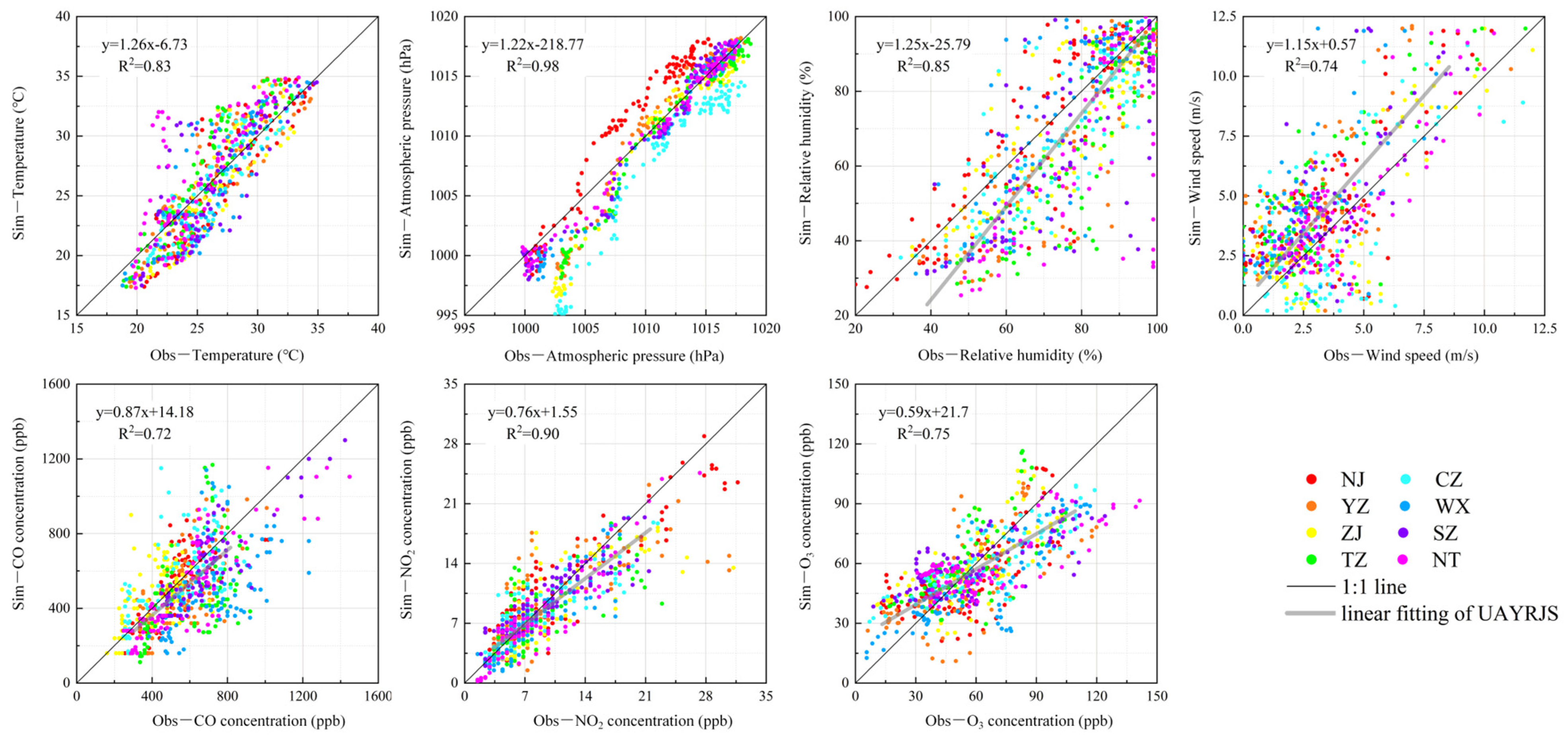
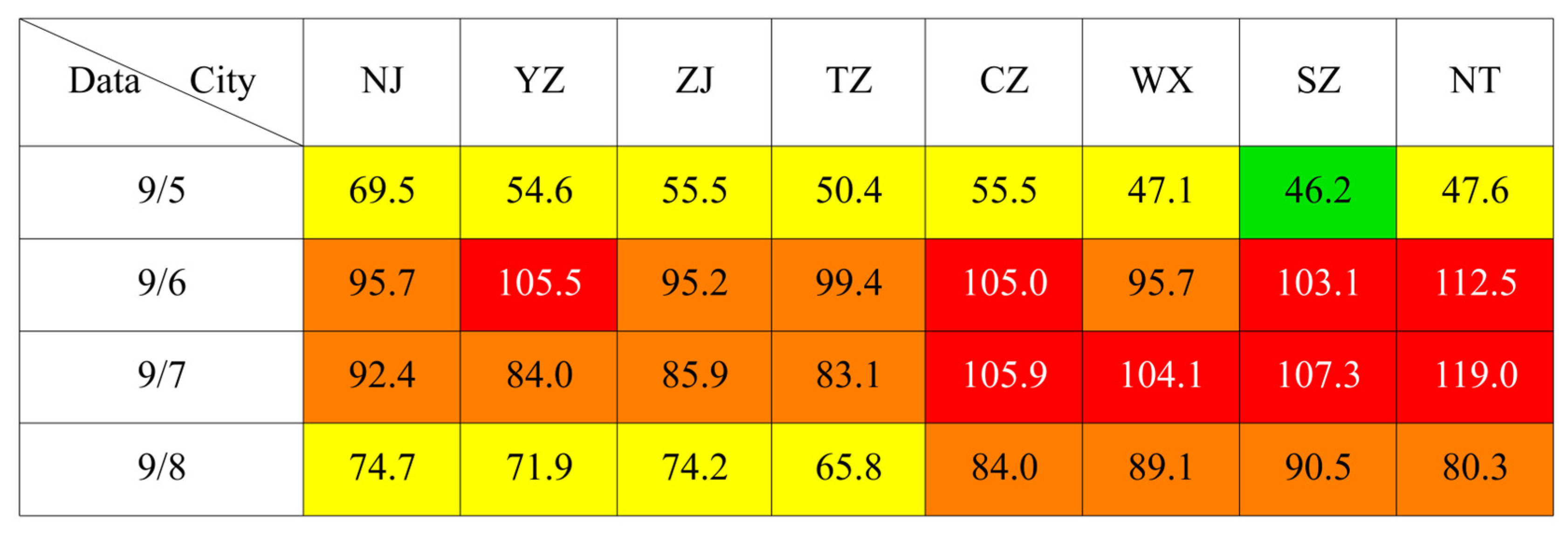
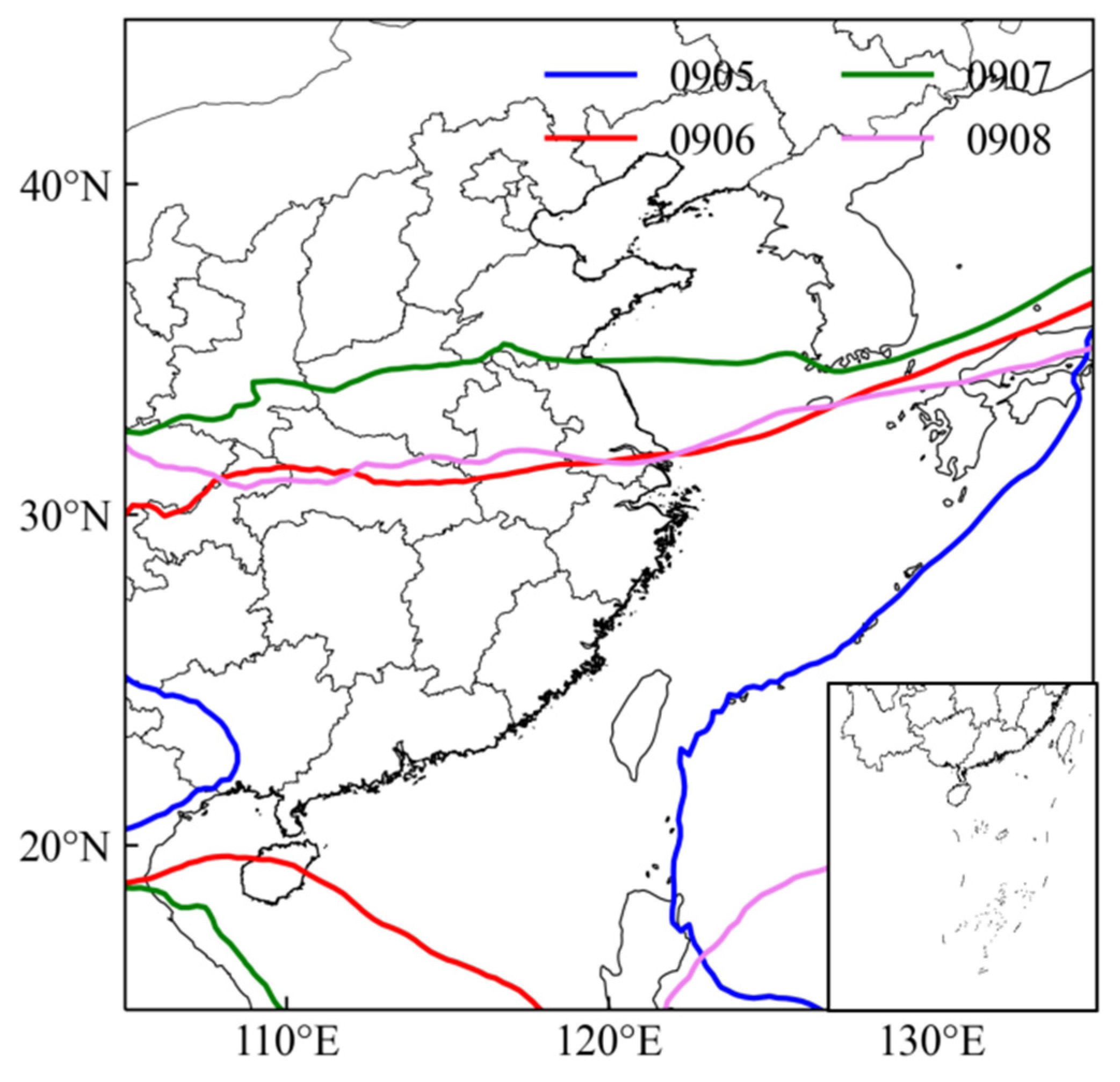
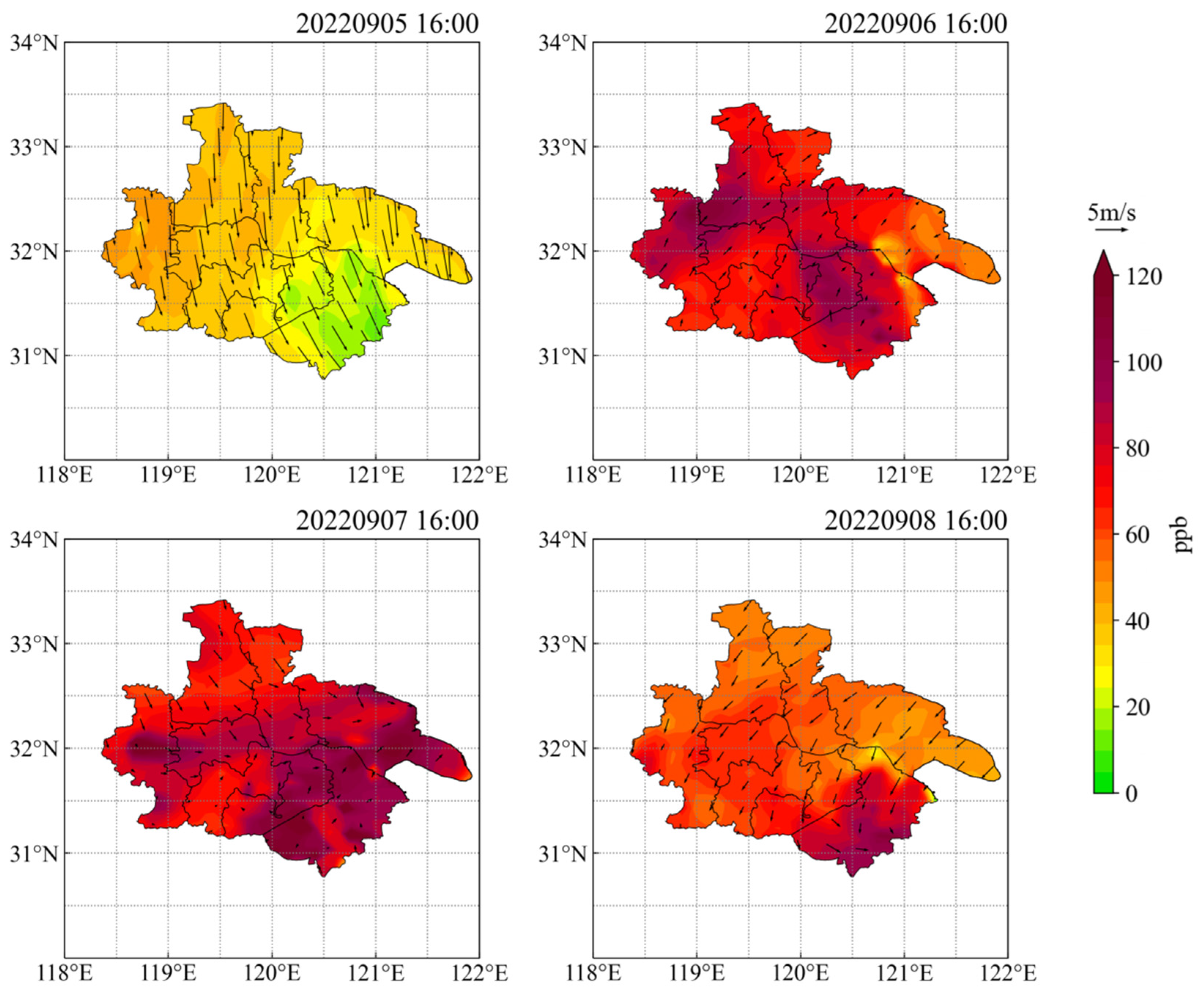
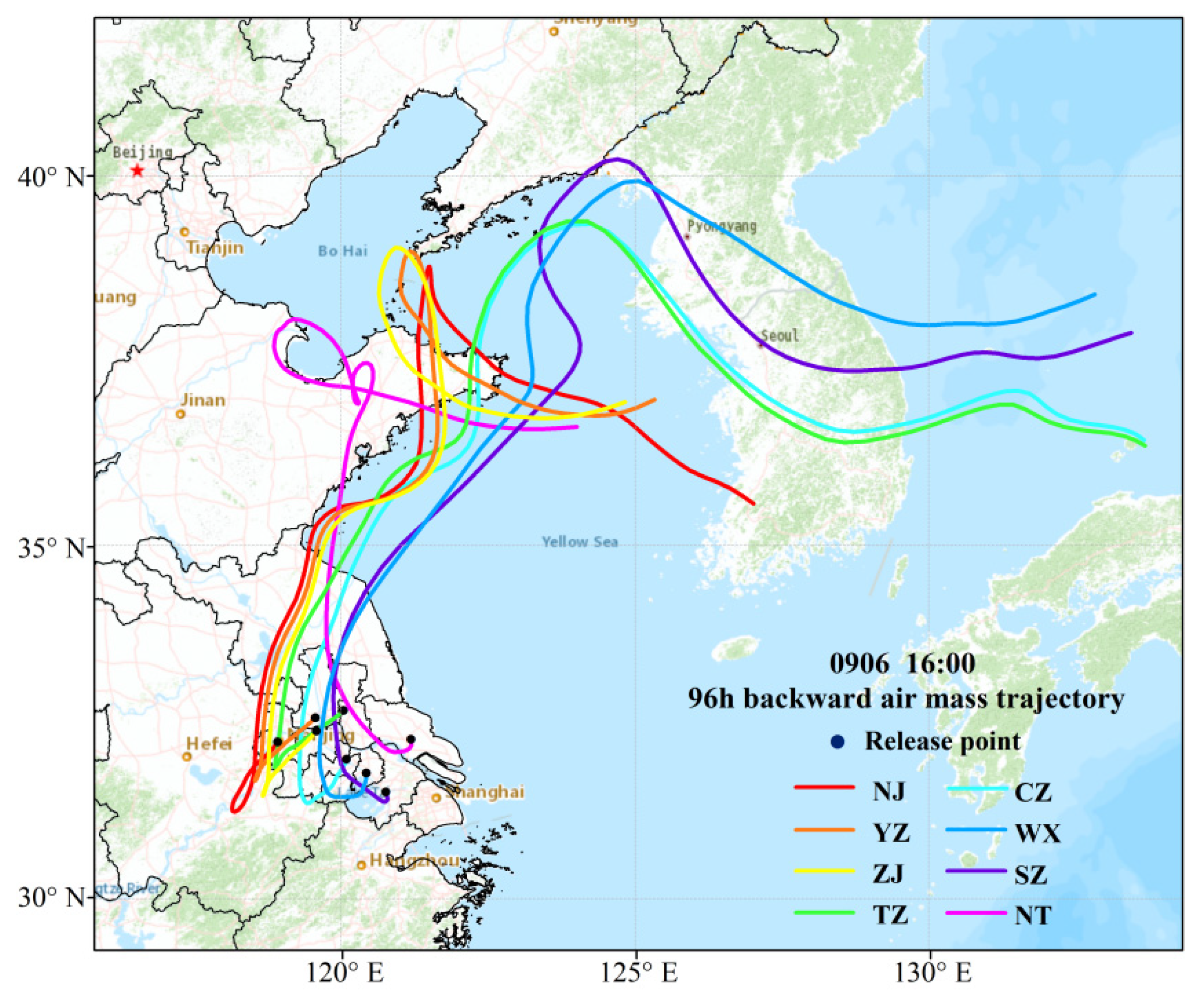
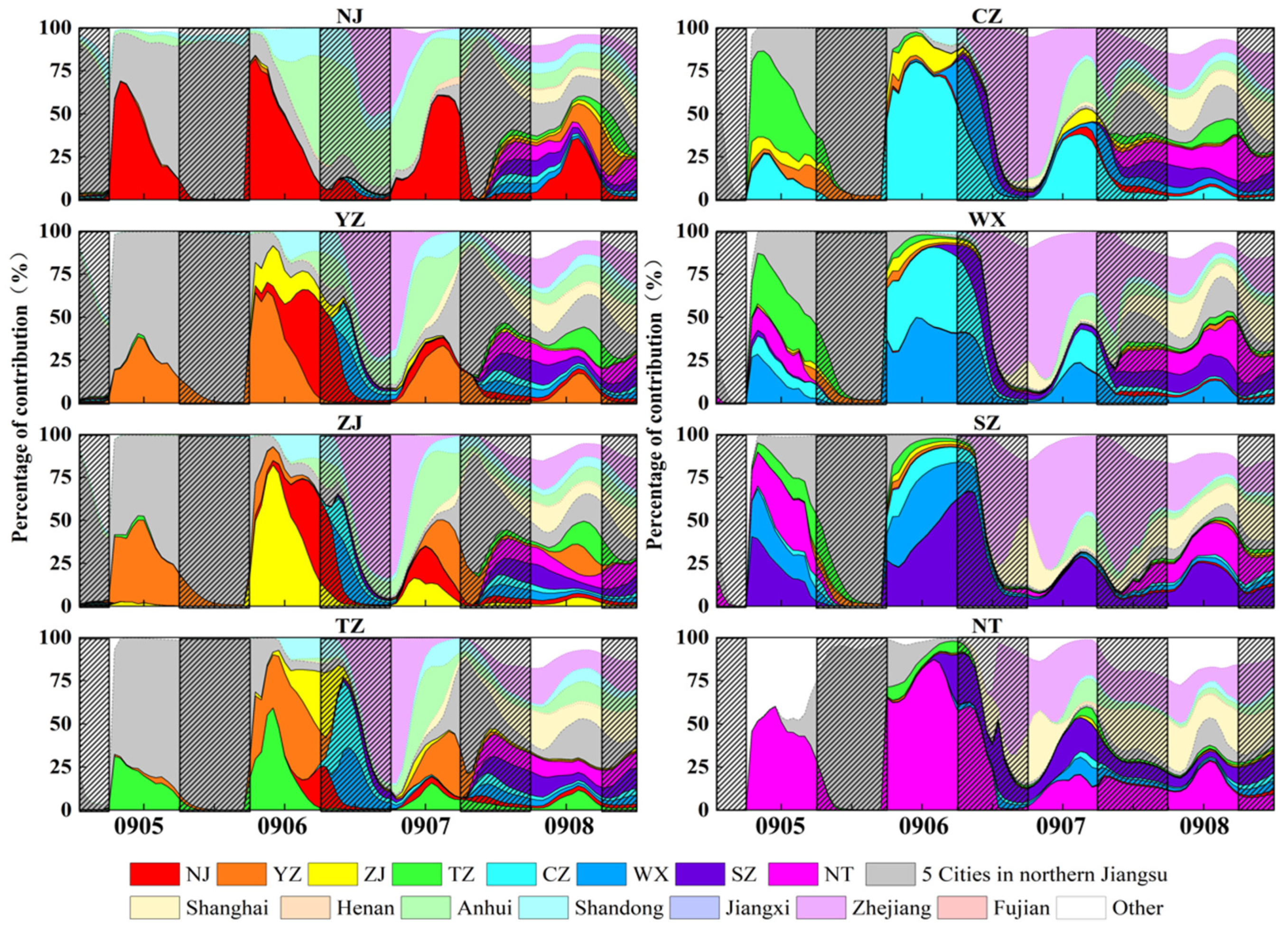
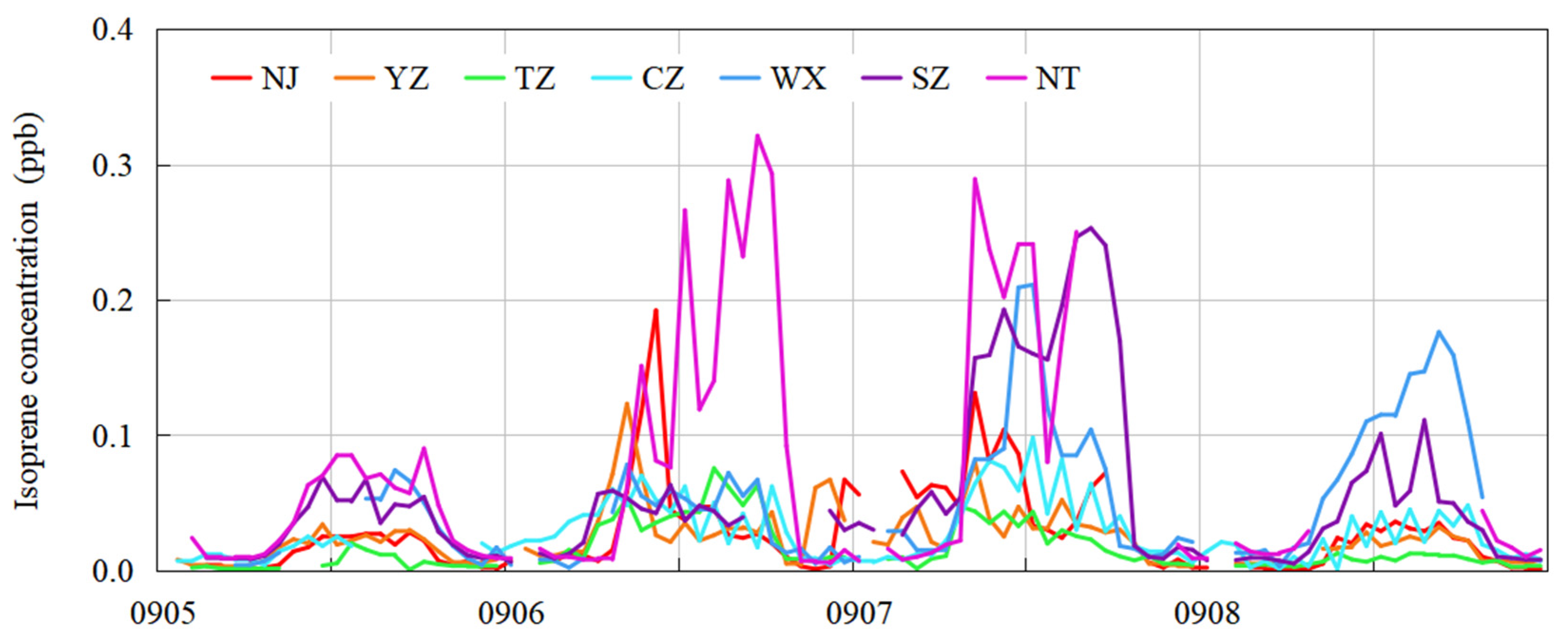
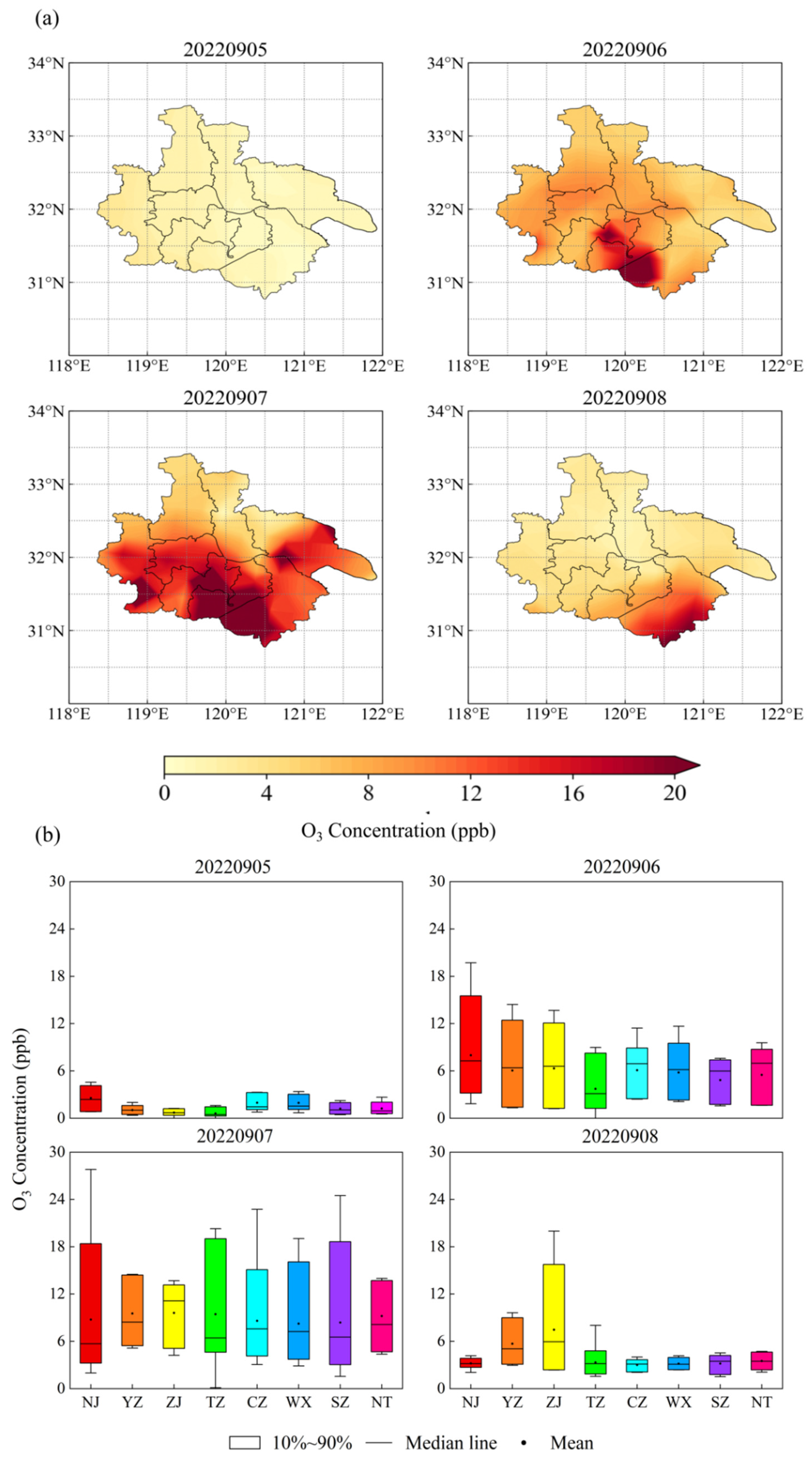
| Scheme Name | Scheme Settings |
|---|---|
| Microphysics | Purdue Lin scheme |
| Cumulus convection | Kain–Fritsch (new Eta) scheme |
| Longwave radiation | RRTM scheme |
| Shortwave radiation | Goddard shortwave |
| Sticky layer | Monin-obukhov |
| Surface layer | Noah Land Surface Model |
| Boundary layer | Yongsei University (YSU) scheme |
| Variables | Mean | MAE | R | RMSE | |
|---|---|---|---|---|---|
| Observation | Simulation | ||||
| Temperature (°C) | 26.0 | 25.9 | −0.09 | 0.91 | 2.09 |
| Sea level pressure (hPa) | 1011.0 | 1010.2 | −0.81 | 0.99 | 1.63 |
| Relative humidity (%) | 74.4 | 67.2 | −7.23 | 0.92 | 11.53 |
| Wind speed (m/s) | 3.3 | 4.3 | 1.06 | 0.86 | 1.73 |
| CO (ppb) | 571.4 | 512.5 | −58.92 | 0.85 | 102.44 |
| NO2(ppb) | 9.2 | 7.5 | −1.71 | 0.64 | 4.11 |
| O3(ppb) | 125.9 | 106.6 | −19.32 | 0.94 | 26.41 |
Disclaimer/Publisher’s Note: The statements, opinions and data contained in all publications are solely those of the individual author(s) and contributor(s) and not of MDPI and/or the editor(s). MDPI and/or the editor(s) disclaim responsibility for any injury to people or property resulting from any ideas, methods, instructions or products referred to in the content. |
© 2024 by the authors. Licensee MDPI, Basel, Switzerland. This article is an open access article distributed under the terms and conditions of the Creative Commons Attribution (CC BY) license (https://creativecommons.org/licenses/by/4.0/).
Share and Cite
Cai, Z.; Zhou, D.; Yu, J.; Zhong, S.; Zheng, L.; Luo, Z.; Tang, Z.; Jiang, F. An Ozone Episode in the Urban Agglomerations along the Yangtze River in Jiangsu Province: Pollution Characteristics and Source Apportionment. Atmosphere 2024, 15, 942. https://doi.org/10.3390/atmos15080942
Cai Z, Zhou D, Yu J, Zhong S, Zheng L, Luo Z, Tang Z, Jiang F. An Ozone Episode in the Urban Agglomerations along the Yangtze River in Jiangsu Province: Pollution Characteristics and Source Apportionment. Atmosphere. 2024; 15(8):942. https://doi.org/10.3390/atmos15080942
Chicago/Turabian StyleCai, Zhe, Derong Zhou, Jianqiao Yu, Sheng Zhong, Longfei Zheng, Zijun Luo, Zhiwei Tang, and Fei Jiang. 2024. "An Ozone Episode in the Urban Agglomerations along the Yangtze River in Jiangsu Province: Pollution Characteristics and Source Apportionment" Atmosphere 15, no. 8: 942. https://doi.org/10.3390/atmos15080942






